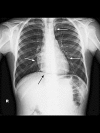Pneumomediastinum and pneumopericardium in an 11-year-old rugby player: a case report
- PMID: 23672393
- PMCID: PMC3600931
- DOI: 10.4085/1062-6050-48.1.11
Pneumomediastinum and pneumopericardium in an 11-year-old rugby player: a case report
Abstract
Objective: Pneumomediastinum and pneumopericardium are rare occurrences in young athletes, but they can result in potentially life-threatening consequences.
Background: While involved in a rugby match, an 11-year-old boy received a chest compression by 3 players during a tackle. He continued to play, but 2 hours later, he developed sharp retrosternal chest pain. A chest radiograph and an echocardiograph at the nearest emergency department showed pneumopericardium and pneumomediastinum.
Differential diagnosis: Sternal and rib contusions, rib fractures, heartburn, acute asthma exacerbation, pneumomediastinum, pneumopericardium, pneumothorax, traumatic tracheal rupture, myocardial infarction, and costochondritis (Tietze syndrome).
Treatment: Acetaminophen for pain control.
Uniqueness: To our knowledge, this is the only case in the international literature of the simultaneous occurrence of pneumomediastinum and pneumopericardium in a child as a consequence of blunt chest trauma during a rugby match.
Conclusions: Pneumomediastinum and pneumopericardium may be consequences of rugby blunt chest trauma. Symptoms can appear 1 to 2 hours later, and the conditions may result in serious complications. Immediate admission to the emergency department is required.
Figures


References
-
- Cummings RG, Wesly RL, Adams DH, Lowe JE. Pneumopericardium resulting in cardiac tamponade. Ann Thorac Surg. 1984;37(6):511–518. - PubMed
-
- Capizzi PJ, Martin M, Bannon MP. Tension pneumopericardium following blunt injury. J Trauma. 1995;39(4):775–780. - PubMed
-
- Leitman BS, Greengart A, Wasser HJ. Pneumomediastinum and pneumopericardium after cocaine abuse. AJR Am J Roentgenol. 1988;151(3):614. - PubMed
-
- Katzir D, Klinovsky E, Kent V, Shucri A, Gilboa Y. Spontaneous pneumopericardium: case report and review of the literature. Cardiology. 1989;76(4):305–308. - PubMed
-
- Toledo TM, Moore WL, Jr, Nash DA, North RL. Spontaneous pneumopericardium in acute asthma: case report and review of the literature. Chest. 1972;62(1):118–120. - PubMed
Publication types
MeSH terms
LinkOut - more resources
Full Text Sources
Other Literature Sources

